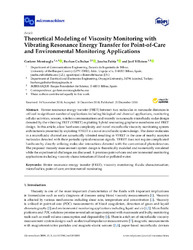Theoretical modeling of viscosity monitoring with vibrating resonance energy transfer for point-of-care and environmental monitoring applications
| dc.contributor.author | Memişoğlu, G. | |
| dc.contributor.author | Gülbahar, Burhan | |
| dc.contributor.author | Zubia, J. | |
| dc.contributor.author | Villatoro, J. | |
| dc.date.accessioned | 2020-08-31T10:08:26Z | |
| dc.date.available | 2020-08-31T10:08:26Z | |
| dc.date.issued | 2019-01-01 | |
| dc.identifier.issn | 2072-666X | en_US |
| dc.identifier.uri | http://hdl.handle.net/10679/6868 | |
| dc.identifier.uri | https://www.mdpi.com/2072-666X/10/1/3 | |
| dc.description.abstract | Forster resonance energy transfer (FRET) between two molecules in nanoscale distances is utilized in significant number of applications including biological and chemical applications, monitoring cellular activities, sensors, wireless communications and recently in nanoscale microfluidic radar design denoted by the vibrating FRET (VFRET) exploiting hybrid resonating graphene membrane and FRET design. In this article, a low hardware complexity and novel microfluidic viscosity monitoring system architecture is presented by exploiting VFRET in a novel microfluidic system design. The donor molecules in a microfluidic channel are acoustically vibrated resulting in VFRET in the case of nearby acceptor molecules detected with their periodic optical emission signals. VFRET does not require complicated hardware by directly utilizing molecular interactions detected with the conventional photodetectors. The proposed viscosity measurement system design is theoretically modeled and numerically simulated while the experimental challenges are discussed. It promises point-of-care and environmental monitoring applications including viscosity characterization of blood or polluted water. | en_US |
| dc.description.sponsorship | European Union (EU) ; Ministerio de Economia y Competitividad (MINECO) ; Eusko Jaurlaritza ; Vestel Electronics Inc. | |
| dc.language.iso | eng | en_US |
| dc.publisher | MDPI | en_US |
| dc.relation | info:eu-repo/grantAgreement/EC/FP7/7123694 | |
| dc.relation.ispartof | Micromachines | |
| dc.rights | openAccess | |
| dc.rights | Attribution 4.0 International | |
| dc.rights.uri | https://creativecommons.org/licenses/by/4.0/ | |
| dc.title | Theoretical modeling of viscosity monitoring with vibrating resonance energy transfer for point-of-care and environmental monitoring applications | en_US |
| dc.type | Article | en_US |
| dc.description.version | Publisher version | en_US |
| dc.peerreviewed | yes | en_US |
| dc.publicationstatus | Published | en_US |
| dc.contributor.department | Özyeğin University | |
| dc.contributor.authorID | (ORCID 0000-0003-3756-3280 & YÖK ID 234525) Gülbahar, Burhan | |
| dc.contributor.ozuauthor | Gülbahar, Burhan | |
| dc.identifier.volume | 10 | en_US |
| dc.identifier.issue | 1 | en_US |
| dc.identifier.wos | WOS:000459735300003 | |
| dc.identifier.doi | https://doi.org/10.3390/mi10010003 | en_US |
| dc.subject.keywords | Forster resonance energy transfer (FRET) | en_US |
| dc.subject.keywords | Viscosity monitoring | en_US |
| dc.subject.keywords | Fluidic characterization | en_US |
| dc.subject.keywords | Microfluidics | en_US |
| dc.subject.keywords | Point-of-care | en_US |
| dc.subject.keywords | Environmental monitoring | en_US |
| dc.identifier.scopus | SCOPUS:2-s2.0-85059612768 | |
| dc.relation.publicationcategory | Article - International Refereed Journal - Institution Academic Staff |
Files in this item
This item appears in the following Collection(s)
Share this page




